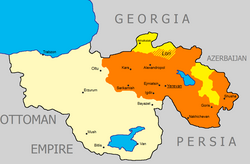First Republic of Armenia
The First Republic of Armenia, 1918–1920, was the first modern establishment of an Armenian republic. The country was created after the Russian Tsarist empire that began with the Russian Revolution of 1917 that lost power. Its creation with borders were the Democratic Republic of Georgia in the north, the Ottoman Empire to the west, the Persian Empire to the south, and Azerbaijan Democratic Republic to the east.
Republic of Armenia Հայաստանի Հանրապետութիւն | |||||||||||||
|---|---|---|---|---|---|---|---|---|---|---|---|---|---|
| 1918–1920 | |||||||||||||
| Anthem: Mer Hayrenik | |||||||||||||
 Territory held by Armenia and the Karabakh Council at some point Territories of Armenia Occupied by Neighboring States Area given to Armenia by the Treaty of Sèvres, which was not ratified and never entered into force.[1] | |||||||||||||
| Capital | Yerevan | ||||||||||||
| Common languages | Armenian | ||||||||||||
| Religion | Armenian Apostolic | ||||||||||||
| Government | Parliamentary republic | ||||||||||||
| Prime Minister | |||||||||||||
• Jun 1918–May 1919 | Hovhannes Kajaznuni | ||||||||||||
• May 1919–May 1920 | Alexander Khatisian | ||||||||||||
• May–Nov 1920 | Hamo Ohanjanyan | ||||||||||||
• Nov–Dec 1920 | Simon Vratsian | ||||||||||||
| Historical era | Interwar period | ||||||||||||
| May 28 1918 | |||||||||||||
| May 28, 1919 | |||||||||||||
• Sovietization | December 2 1920 | ||||||||||||
| Area | |||||||||||||
| mid-1918 (after the Treaty of Batum)[2][3] | 11,000 km2 (4,200 sq mi) | ||||||||||||
| 1919 (after the Armistice of Mudros)[4] | 70,000 km2 (27,000 sq mi) | ||||||||||||
| 1920 (per the Treaty of Sèvres; never realized)[5] | 160,000 km2 (62,000 sq mi) | ||||||||||||
| Population | |||||||||||||
| 500000 | |||||||||||||
• 1919 (after the Armistice of Mudros)[4] | 1300000 | ||||||||||||
| Currency | Armenian ruble | ||||||||||||
| ISO 3166 code | AM | ||||||||||||
| |||||||||||||
End of the Republic, 1920 change
Armenia gave way to communist power in late 1920. In September 1920, the Turkish revolutionaries moved in on the capital. First an armistice was concluded, on November 18, and then a full peace treaty - Treaty of Alexandropol on 2nd and/or 3rd of December 1920.
During that time, the Soviet 11th Red Army invasion started on the 29th of November 1920. The actual transfer of power took place on December 2 in Yerevan. Armenian leadership approved an ultimatum, presented to it by the Soviet plenipotentiary Boris Legran - who was at work as one of major Russian diplomats on Caucasus at that time. Armenia decided to join the Soviet sphere, while the Soviet Russia agreed to protect its remaining territory from the advancing Turkish army. Soviets also pledged to take steps to rebuild the army, protect the Armenians, not to pursue non-communist Armenians. None of these promises were kept.
On December 4, 1920, the Red Army entered Yerevan, the government of Armenian Republic effectively stopped working. On December 5, the Armenian Revolutionary Committee (Revkom; made up of mostly Armenians from Azerbaijan) also entered the city. Finally, on the following day, December 6, Felix Dzerzhinsky's dreaded secret police, the Cheka, entered Yerevan, thus effectively ending the existence of the Democratic Republic of Armenia.[6] The rest of Armenia was under control of the communist government. The part by Turkey remained for the most part theirs - by the subsequent Treaty of Kars. Soon, the Armenian Soviet Socialist Republic was proclaimed, under the leadership of Aleksandr Miasnikyan. It was to be included into the newly created Transcaucasian Soviet Federated Socialist Republic.
Related pages change
References change
- ↑ Hille, Charlotte Mathilde Louise (2010). State Building and Conflict Resolution in the Caucasus. Leiden, Netherlands: Brill. p. 151. ISBN 978-90-04-17901-1.
- ↑ Hewsen, Robert (2001). Armenia: A Historical Atlas. Chicago: University of Chicago Press. p. 235. ISBN 0-226-33228-4.
- ↑ Walker, Christopher J. (1990). Armenia: The Survival of a Nation (revised second ed.). New York: St. Martin's Press. p. 257. ISBN 9780312042301.
- ↑ Chiclet, Christophe (2005). "The Armenian Genocide" in Turkey Today: A European Country? Olivier Roy (ed.) London: Anthem Press. p. 167. ISBN 1-84331-173-9.
- ↑ Hakobyan, Tatul (9 August 2015). "Sèvres: The Unfulfilled Armenian Dream". ANI Armenian Research Center. Archived from the original on 9 February 2018. Retrieved 1 December 2017.
If the Treaty of Sèvres had been realised, the Republic of Armenia would have covered a territory of over 160 thousand square kilometres.
- ↑ Robert H. Hewsen. Armenia: A Historical Atlas, p. 237. ISBN 0-226-33228-4

